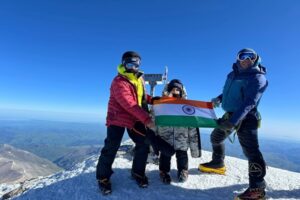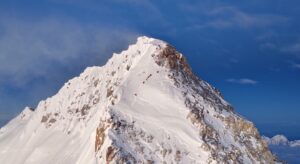So far, we know of four people who will try to climb Everest without oxygen this spring. All four are women. While more climbers may attempt it, no-O2 climbs, especially on Everest’s crowded South Side, have become a rarity.
For that reason, an Everest summit without supplementary oxygen remains a prestigious feat, especially for women record-seekers. Still, not all no-O2 climbs are equal. How much support was used? Did the Sherpa guides use oxygen? Did they carry backup oxygen for the climber, just in case? Let’s look at some of these nuances.
Women rule
Dabuti Sherpa of Nepal is a member of Marc Batard’s small team. Batard, a French former speed climber, will turn 72 this year. He is trying to open an alternative route to Everest’s Camp 2 around the dangerous Khumbu Icefall.
“My second priority is to allow Dabuti Sherpa to become the first Nepali woman to climb Everest without artificial oxygen,” Batard told ExplorersWeb.
Indeed, while several Nepali women have summited Everest, all did so with supplementary O2. By contrast, Nepali men have summited a total of 64 times without bottled gas. (That number includes those who have done so more than once.)

Dabuti Sherpa, a member of Marc Batard’s team. Photo: Everest en Partage
“If all goes well and I’m in good physical shape, I might try the climb myself,” Batard told ExplorersWeb.
Dabuti is not the only Nepal-born woman looking to climb Everest without oxygen this spring. Although she is now an Indian citizen, Asmita Dorjee was born in Thamo village in the Khumbu Valley. Her story is worth a Netflix series. Her father was a climbing Sherpa who worked on the 1984 expedition in which India’s Bachendri Pal became the first Indian woman to summit Everest.
When Dorjee’s father died, Bachendri Pal adopted her, Dawa Steven told ExplorersWeb. Today, Dorjee is a mountaineering instructor for the TATA Steel Adventure Foundation. She reached 8,700m on her first no-O2 Everest attempt last year and summited Manaslu without oxygen in the fall. Dorjee is a member of the Asian Trekking team.

Stefi Troguet of Andorra will try to reprise what she did on K2 last summer and climb Everest without gas as a member of Nirmal Purja’s team. As on K2, Troguet will be the only client on the Elite Exped team to climb no-O2.
This means that she’ll have to find a way to adjust her timing and rotations, which will take her longer than those clients on oxygen. Commercial clients usually don their oxygen masks around 6,400m. Troguet is going straight to Everest, so she will not have a chance to acclimatize on any lesser peak.
The Andorran will climb without O2 or not at all, she says, even if it jeopardizes her summit. At least, she adds, she will not use it to go up the mountain.
Finally, Viridiana Alvarez of Mexico will also attempt Everest without oxygen. She is a regular client of Seven Summit Treks.

Stefi Troguet during an ice climbing day in the Pyrenees recently. Photo: Stefi Troguet/Facebook
Nuances
If successful, all three women mentioned here would become the first in their respective countries to summit Everest without oxygen. All three, we should note, will have O2-assisted staff supporting them in their climb.
This means that oxygen will be available to them if they need it. As well, on commercial expeditions — especially on Everest — Sherpa support involves not only safety but also assistance with every chore, from cooking to melting ice for water to carrying gear and supplies. This saves climbers a tremendous amount of effort. On the other hand, even with this assistance, climbing up to 8,849m on your own is far harder than erasing the effects of altitude with artificial oxygen.

David Goettler on the summit of Everest with no oxygen or personal Sherpa support. Photo: Facebook
Is it even possible to climb Everest in a better style these days? Realistically, individual climbers hoping to summit without oxygen have few options besides the normal route. Okay, if you are Jost Kobusch or a very few other climbers, then you might try something different. But climbing the normal route means using the fixed ropes and following a well-packed trail.
At the same time, the more self-sufficient the climber, the more meritable the ascent. David Goettler summited Everest last year without Sherpa support. He carried his own gear up and down the mountain. He freely admitted that he had used the ropes at some points and he also took advantage of an empty tent platform along the way. Otherwise, he relied on his own abilities and decisions.
Other potential climbers
Kilian Jornet is also expected in Nepal this spring. He just says that he will be there with his family (his wife and their two young daughters). He revealed no climbing plans, yet he has teamed up with Goettler on previous no-O2 attempts.
Previously, Jornet needed no team support. He paid for the permits, the use of the ropes, the Icefall work, and the liaison officer. His base camp was a lodge. We will keep an eye on him, in case he considers an individual ascent.
The controversial Grace Tseng of Taiwan has announced plans to return to Everest. She summited it back in 2021, but this time, she wants to go fast and without O2.
Kristin Harila of Norway hopes to repeat her 14×8,000m speed list this year. She mentioned that she would like to climb as many peaks as possible without O2. It is not clear if Everest will be one of them.
In a recent post on social media, Harila suggested that she might still obtain permits for Shishapangma and Cho Oyu this spring. The Chinese and Tibetan Mountaineering Associations have said nothing about this.
A significant number of climbers from China and India will flock to Everest in April. It is possible that some of them will try without oxygen.
An increasing number of Nepali guides hope to do so as well, to improve their climbing resumes. On the lower 8,000’ers, some strong Sherpas may climb without O2, as long as their expedition leaders and clients agree in advance.
Fast-climbing staff occasionally attempt a quick no-O2 ascent before or after their commercial work. On Everest, however, logistics rarely allow such flexibility, but Mingma G of Imagine Nepal managed it last spring. Gasping on the summit, he says that he had fulfilled a dream of climbing Everest without O2.
More climbers, fewer without O2
Every year, more and more climbers flock to Everest but fewer attempt it without O2. Last year featured nearly 700 summits but only four no-O2 ascents (guides Nirmal Purja and Mingma G, plus David Goettler, and Jing He of China). There were three no-O2 ascents in 2019 and one in 2018.
One of the hurdles facing would-be no-O2 climbers is the crowds on the South Side. Unlike those on oxygen, they can’t queue for hours in long lines. They must get up and down quickly. Once the Tibetan side of the mountain reopens, more experienced people might decide to try without O2 on this less crowded side.

Climbers approach the summit of Everest. Photo: Pange Sherpa






